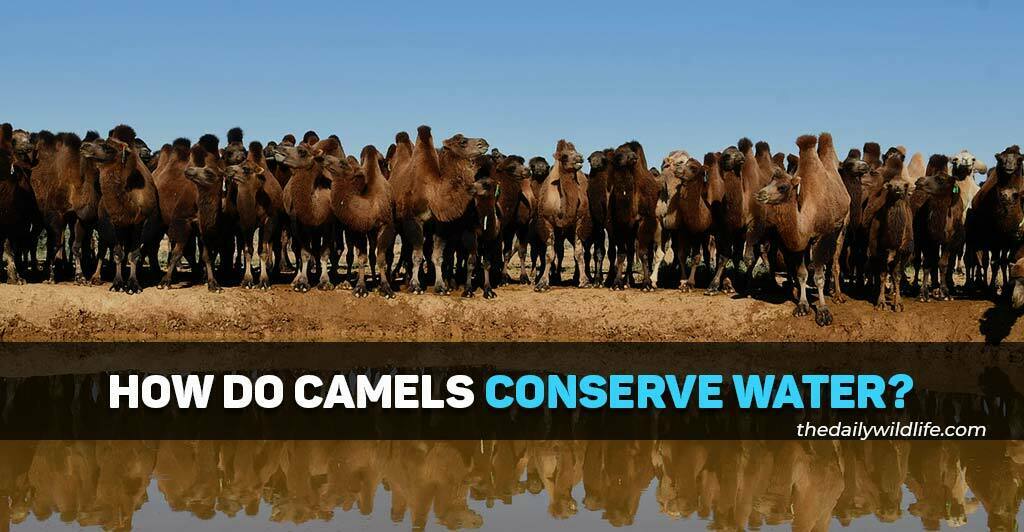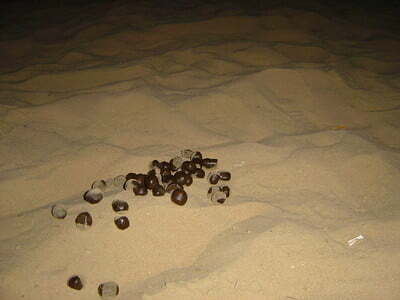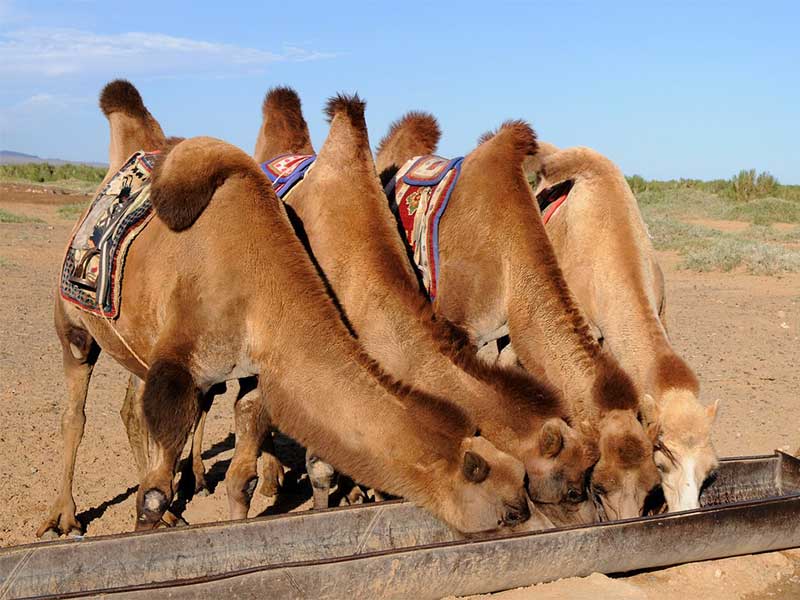Camels have several mechanisms and adaptations to preserve water. Thick fur reflects sun rays, hump carries fat that can be turned into water, concentrated urine and dry feces have little water amount, nostrils can close and save water, and body temperature can fluctuate so camels sweat less.
“How do camels conserve water’ is an excellent question considering that these animals live in some of the hottest parts of the world.
The Sahara desert, where dromedary camels live, can have summer temperatures going from an average of 104 °F (40 °C) up to 117 °F (47 °C).
The Gobi desert, where Bactrian camels live, has summer temperatures between 77 °F and 113 °F (25-45 °C).
Here are all of the adaptations that help them survive in the desert and preserve water.

To Save Water, Camels Fluctuate Their Daily Body Temperature
Throughout the day, camels will thermoregulate their body temperature; increasing or decreasing to follow the temperature of the air.
When it is properly hydrated, a camel’s body temperature goes between 96.8 °F and 102 °F (36-39 °C). A dehydrated camel will change its body temperature between 93 °F and 105 °F (34-40.7 °C). [1]
In a camel weighing around 1100 lbs (500 kg), this 43 °F (6.2 °C) fluctuation in body temperature saves around 2500 kcal, which is around 5 liters of water (sweat) a day.
This mechanism where a camel thermoregulates its body temperature according to the outside one is called “adaptive heterothermy”.
Camels Will Also Increase Their Body Temperature To Sweat Less

Like most other mammals, camels reduce heat by sweating. The water evaporates from the skin and removes excess heat from the body. When 1g of water evaporates, it removes about 0.6 kcal of heat. [2]
For camels, sweating means water loss. And because there is not too much water in the desert, camels will try to hold onto as much of it as possible.
That’s why they increase their body temperature, to get it close to the outside one. The closer those temperatures are, the less the camels need to sweat.
Only when a camel reaches a critical body temperature of around 105°F (40.7°C), it will sweat; that’s the temperature they abandon water-saving in favor of immediate survival.
The sweat is released via sweat glands; camels have around 200 per 0.15 square inches (1 cm2) of the body. This is similar to a number humans have.
Camels Will Also Reduce Their Metabolic Rate To Save Water
Contrary to other mammals, in camels, dehydration leads to a reduction in the metabolic rate. When they are dehydrated, camels will naturally move and eat less.
When the temperatures are extremely high, camels inhibit the production of a hormone called thyroxine. This decreases water loss from breathing and reduces metabolic rate, which allows the camel to stay hydrated longer and cool down better. [3]
Camels will, under high ambient temperatures, also increase their respiratory rate, and breathe more often. They will go from 6-11 to 8-18 breaths per minute.
However, this increase in breathing rate will not significantly increase evaporation or loss of water.
Camels Will Also Produce Concentrated Urine And Dry Feces
Their digestive and urinary tracts are well-specialized in water conservation.
To conserve as much water as possible, camels have excellently adapted kidneys and long intestine.
Kidneys in camels have a long loop of Henle, which helps produce urine that is far more concentrated than blood, and a well-developed medulla. All of this limits the amount of water needed for intake to survive.
During dehydration, the kidneys reduce water losses both by decreasing the glomerular filtration rate and by increasing the tubular reabsorption of water. [4]
A dehydrated camel will urinate in drops a highly concentrated, salty, and syrupy urine.
For example, cattle lose 5.2-10.5 gallons (20-40 l) of fluid daily through urination and feces, whereas camels lose only 0.3 gallons (1.3 liters) or less.
Camels also have extremely long intestines that absorb every last drop of water from the foods they eat and produce very dry and small balls of feces.

Image by Daniel Kwok via Flickr | CC BY 2.0
Camel’s Nostrils Work As A Dehumidifier And Save Water
Camels have flexible nostrils, huge nasal passages, and strong narial muscles. This allows them to close the nostrils at will, but also to save water.
When a camel gets dehydrated, its nasal surfaces help it save water by cooling the exhaled air during the night, and by extracting vapor from that exhaled air.
During the day, the exhaled air has the temperature of the body and is fully saturated.
During the night, it has the temperature of the outside air and approximately 75% relative humidity.
This combination of cooling and desaturation can provide a saving of water of 60% relative to the exhalation of saturated air at body temperature. [5]
Camel’s Fur Prevents Heat From Reaching The Skin
During summer camels will develop lighter-colored coat. This will reflect sun rays and prevent heat from getting to the skin.
That way heat is not transferred to the animal and does not get to raise its body temperature. As a result, less water is spent on trying to cool down. [6]
During the winter, camels will grow thick and coarse fur to save them from the extreme lows.
Camels Will Also Drink Huge Amounts Of Water When Available

Because they do not know when is the next time they drink water, camels will consume about 53 gallons (200 l) of water in a few minutes.
Camels hold that water in their stomachs and their bloodstream.
And because of their stomach, which serves as water storage, and their blood cell structure, camels can consume such an amount with no consequences to their health.
The first chamber of the stomach, rumen, has water cells areas that can carry water. It has storage approximately equal to 20% of the bodyweight of a camel. And during rapid hydration, the rumen plays a role in the prevention of hemolysis and osmotic tissue shock.
The camel’s oval blood cells can expand up to 240% of their original volume without rupturing; our blood cells could not tolerate such osmotic pressure. A camel may drink more than one-third of its body weight as it rehydrates.
When a camel gets dehydrated, it will first use the water from the rumen. Around 50-70% of water lost during dehydration is that fluid from the stomach. [7]
The Lifespan Of The Camel’s Red Blood Cells Helps Save Water
In hydrated camels, the erythrocytes (red blood cells) get renewed every 90 to 120 days. However, when a camel is severely dehydrated, the life span of erythrocytes extends to 150 days. [8]
Red blood cell turnover requires water and energy; extending their lifespan reduces energy and water expenditure.
A Camel’s Hump Also Works As A Water Source
When there is not enough food and water available, in the presence of oxygen, fat from the hump is metabolized and transformed into energy and water. This water is used for hydration.
And contrary to a popular belief, camels do not store water in their hump. When there is no food for extended periods, the humps will visibly become limp and fall on one side of the body.

Camel’s body can tolerate water loss of over 30% of its body weight; most mammals would die if they lost half of this value.
TL;DR – How Do Camels Conserve Water?
Camels save water thanks to their thick fur, fatty humps, nostrils, kidneys, and body thermoregulation. By fluctuating their daily body temperature, camels sweat less, their fur prevents hot air from reaching the skin, and kidneys and stomach produce little urine and dry feces.
We hope you found the article informative and that we managed to answer the question “how do camels conserve water” properly.
References
[1] Tibary, Ahmed, and Khalid El Allali. “Dromedary camel: A model of heat resistant livestock animal.” Theriogenology 154 (2020): 203-211.
[2] MR, Fath El-Bab, A. S. Abou-Elhamd, and M. Abd-Elkareem. “How the structure of the sweat glands of camel symphonizes their reliable function.” J. Anim. Health Prod 5.1 (2017): 19-23.
[3] Bornstein, S. “The ship of the desert. The dromedary camel (Camelus dromedarius), a domesticated animal species well adapted to extreme conditions of aridness and heat.” Rangifer (1990): 231-236.
[4] Siebert, B. D., and W. V. Macfarlane. “Water turnover and renal function of dromedaries in the desert.” Physiological Zoology 44.4 (1971): 225-240.
[5] Schmidt-Nielsen, Knut, R. C. Schroter, and A. Shkolnik. “Desaturation of exhaled air in camels.” Proceedings of the Royal Society of London. Series B. Biological Sciences 211.1184 (1981): 305-319.
[6] Abd Elgader, Marwa-Babiker, Mohamed Osman Eisa, and Ismail ElFagir. “Morphology and Morphometry of Raw Camel Hair of Some Sudanese Camel types in Kordofan States.” Nova Journal of Medical and Biological Sciences 6.1 (2017).
[7] Gebreyohanes, M. G., and A. M. Assen. “Adaptation mechanisms of camels (Camelus dromedarius) for the desert environment: a review.” J. Vet. Sci. Technol 8.6 (2017): 1-5.
[8] Ouajd, Souilem, and Barhoumi Kamel. “Physiological particularities of dromedary (Camelus dromedarius) and experimental implications.” Scandinavian Journal of Laboratory Animal Sciences 36.1 (2009): 19-29.